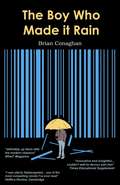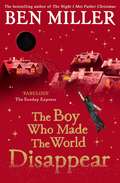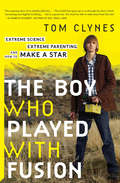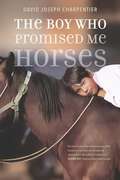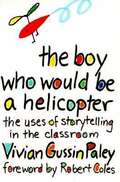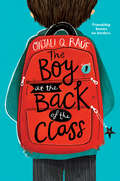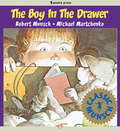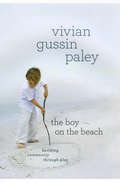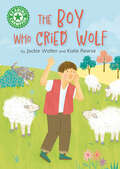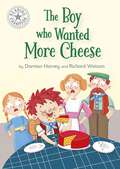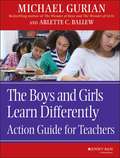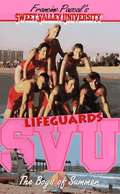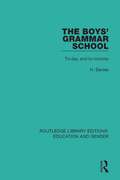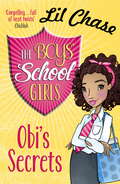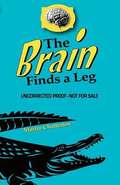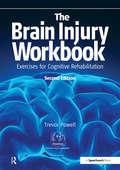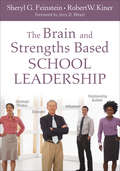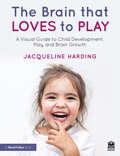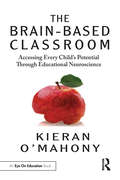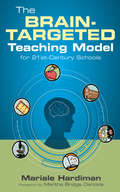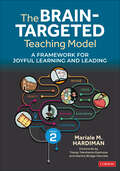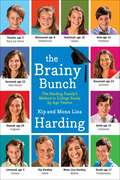- Table View
- List View
The Boy Who Made it Rain
by Brian ConaghanBrian Conaghan’s first book.For age 13+. "innovative and insightful... couldn’t wait to devour part two" - Times Educational Supplement"I was utterly flabbergasted... one of the most compelling novels I've ever read" - Heffers Review, Cambridge "Brilliant writing, brilliant structure, brilliant book" - Des Dillon, author of Me and Ma Gal"definitely up there with the modern classics" - What? Magazine"A Must-Read for Teens and Adults: The Boy Who Made It Rain is an innovative novel that will keep you glued to the story until you turn the last page and learn the final outcome." - Fran Lewis, New York Reviewer.The storyWhen a school tragedy happens, you probably lay the blame on society, the Internet, TV or violent films. Not many of you think it could be the parents' or the teachers' fault, do you? But then, is it? We all have our say, spout off opinions in different directions according to our view of the world. In this novel, too, they all have their say, but who's right?At only sixteen Clem's world is turned upside down. His Willy-Loman-like father, a travelling salesman and a loser, is transferred from Eastbourne to Glasgow and along with him go Clem and his meek accommodating mother. But Glasgow is rough and Clem's posh English accent is not well-accepted in the sink school he attends. And he's a brilliant scholar. He soon becomes the target for McEvoy's group of thugs for whom slashing faces is the most important ambition in their depraved lives.
The Boy Who Made the World Disappear
by Ben Miller&‘A sheer delight for all kids both big AND small&’ Ruth Jones on The Night I Met Father Christmas 'Bubbles with warmth and mischievous humour . . . irresistible' Alexander Armstrong on The Night I Met Father Christmas'Wonderful, funny, magical' Chris Evans on How I Became a Dog Called MidnightEnter a world of wonder with an instant classic from comedian, actor and bestselling children's author, Ben Miller! Harrison tries his best to be good. He doesn&’t steal, he always shares with his sister and he never cheats at board games, but Harrison also has a BIG flaw . . . He can't control his temper!So when he&’s given a black hole instead of a balloon at a party, Harrison jumps at the chance to get rid of everything that makes him cross. But when it&’s not just things he hates that are disappearing into the black hole but things he loves, too, Harrison starts to realize that sometimes you should be careful what you wish for...An out-of-this-world adventure about twists of fate, time travel and troublesome black holes, Ben Miller's stunning storytelling is brought to life with beautiful illustrations from Daniela Jaglenka Terrazzini. Praise for Ben Miller:'A magical adventure' Sunday Express on The Day I Fell Into a Fairytale'Great for reading aloud' The Week Junior on The Day I Fell Into a Fairytale'A fire-side gem of a story' Abi Elphinstone on The Night I Met Father Christmas'Fabulous' Sunday Express on The Boy Who Made the World Disappear'Enchanting, funny and intriguing in equal measure' Philip Ardagh on The Night I Met Father Christmas'Each of [Ben&’s] five books is joyous and thoughtful' Red Magazine
The Boy Who Played with Fusion: Extreme Science, Extreme Parenting, and How to Make a Star
by Tom Clynes2016 PEN/E. O. Wilson Literary Science Writing Award Finalist "The amazing story of an unbelievable boy . . . The world that opens up to us through his story is both fascinating and slightly terrifying . . . but in a good way. You won't be able to walk away from this tale." -- Elizabeth Gilbert, author of Eat, Pray, Love"Imagine if cartoon whiz kid Jimmy Neutron were real and had a brainchild with MacGyver and his adolescence got told as a rollicking bildungsroman about American prodigies and DIY nuclear reactors--well, that's this book." --Jack Hitt, author of Bunch of Amateurs By the age of nine, Taylor Wilson had mastered the science of rocket propulsion. At eleven, his grandmother's cancer diagnosis inspired him to investigate new ways to produce medical isotopes. And by fourteen, Wilson had built a 500-million-degree reactor and become the youngest person in history to achieve nuclear fusion. How could someone so young achieve so much, and what can Wilson's story teach parents and teachers about how to support high-achieving kids? In The Boy Who Played with Fusion, science journalist Tom Clynes narrates Taylor's extraordinary journey--from his Arkansas home, to a unique public high school just for academic superstars, to the present, when Wilson is designing devices to prevent terrorists from shipping radioactive material and inspiring a new generation to take on the challenges of science. "Clynes guides us on an engrossing journey to the outer realms of science and parenting. The Boy Who Played with Fusion is a fascinating exploration of 'giftedness' and all its consequences." --Paul Greenberg, author of Four Fish and American Catch "An essential contribution to our understanding of the most important underlying questions about the development of giftedness, talent, creativity, and intelligence." --Psychology Today
The Boy Who Promised Me Horses
by David Joseph Charpentier&“He tried to outrun a train,&” Theodore Blindwoman told David Joseph Charpentier the night they found out about Maurice Prairie Chief&’s death. When Charpentier was a new teacher at St. Labre Indian School in Ashland, Montana, Prairie Chief was the first student he met and the one with whom he formed the closest bonds. From the shock of moving from a bucolic Minnesota college to teach at a small, remote reservation school in eastern Montana, Charpentier details the complex and emotional challenges of Indigenous education in the United States. Although he intended his teaching tenure at St. Labre to be short, Charpentier&’s involvement with the school has extended past thirty years. Unlike many white teachers who came and left the reservation, Charpentier has remained committed to the potentialities of Indigenous education, motivated by the early friendship he formed with Prairie Chief, who taught him lessons far and wide, from dealing with buffalo while riding a horse to coping with student dropouts he would never see again. Told through episodic experiences, the story takes a journey back in time as Charpentier searches for answers to Prairie Chief&’s life. As he sits on top of the sledding hill near the cemetery where Prairie Chief is buried, Charpentier finds solace in the memories of their shared (mis)adventures and their mutual respect, hard won through the challenges of educational and cultural mistrust.
The Boy Who Would Be a Helicopter
by Vivian Gussin PaleyHow does a teacher begin to appreciate and tap the rich creative resources of the fantasy world of children? What social functions do story playing and storytelling serve in the preschool classroom? And how can the child who is trapped in private fantasies be brought into the richly imaginative social play that surrounds him? The Boy Who Would Be a Helicopter focuses on the challenge posed by the isolated child to teachers and classmates alike in the unique community of the classroom. It is the dramatic story of Jason-the loner and outsider-and of his ultimate triumph and homecoming into the society of his classmates. As we follow Jason's struggle, we see that the classroom is indeed the crucible within which the young discover themselves and learn to confront new problems in their daily experience. Vivian Paley recreates the stage upon which children emerge as natural and ingenious storytellers. She supplements these real-life vignettes with brilliant insights into the teaching process, offering detailed discussions about control, authority, and the misuse of punishment in the preschool classroom. She shows a more effective and natural dynamic of limit-setting that emerges in the control children exert over their own fantasies. And here for the first time the author introduces a triumvirate of teachers (Paley herself and two apprentices) who reflect on the meaning of events unfolding before them.
The Boy at the Back of the Class
by Onjali RaúfIn the vein of timely titles such as Katherine Applegate's Wishtree and Alan Gratz's Refugee comes a touching, accessible middle-grade debut about the ongoing Syrian refugee crisis, as well as the life-changing power of friendship and standing as an ally.There used to be an empty chair at the back of Mrs. Khan's classroom, but on the third Tuesday of the school year a new kid fills it: nine-year-old Ahmet, a Syrian refugee. The whole class is curious about this new boy--he doesn't seem to smile, and he doesn't talk much. But after learning that Ahmet fled a Very Real War and was separated from his family along the way, a determined group of his classmates bands together to concoct the Greatest Idea in the World--a magnificent plan to reunite Ahmet with his loved ones.Balancing humor and heart, this relatable story about the refugee crisis from the perspective of kids highlights the community-changing potential of standing as an ally and reminds readers that everyone deserves a place to call home."This moving and timely debut novel tells an enlightening, empowering, and ultimately hopeful story about how compassion and a willingness to speak out can change the world." --School Library Journal, Starred Review Overall Winner of the 2019 UK Waterstones Children's Book PrizeWinner of the 2019 UK Blue Peter Book AwardA CLIP Carnegie Medal Children's Book Award Nominee
The Boy in the Drawer
by Robert Munsch Michael MartchenkoShelley finds a small boy in her drawer who causes a lot of trouble.
The Boy on the Beach: Building Community Through Play
by Vivian Gussin PaleyWhat can the richly imagined, impressively adaptable fantasy world of children tell us about childhood, development, education, and even life itself? Paley presents a wise appreciation of the importance of play and enduring curiosity about the nature of childhood and the imagination.
The Boy who Cried Wolf: Independent Reading Green 5 (Reading Champion #524)
by Jackie WalterThis story is part of Reading Champion, a series carefully linked to book bands to encourage independent reading skills, developed with Dr Sue Bodman and Glen Franklin of UCL Institute of Education (IOE)In this retelling of a traditional tale, a young shepherd boy gets fed up when he looks after the sheep. He cries, "Wolf!" to play a trick on the people in the village. Then, one day, a wolf really does come, and he discovers why it doesn't pay to tell lies... Reading Champion offers independent reading books for children to practise and reinforce their developing reading skills.Fantastic stories are accompanied by engaging artwork and a reading activity. Each book has been carefully graded so that it can be matched to a child's reading ability, encouraging reading for pleasure. This retelling of the original traditional tale is suitable for children aged 5-7, or those reading at book band Green 5.
The Boy who Wanted More Cheese: Independent Reading White 10 (Reading Champion #1077)
by Damian HarveyThis story is part of Reading Champion, a series carefully linked to book bands to encourage independent reading skills, developed with Dr Sue Bodman and Glen Franklin of UCL Institute of Education (IOE)The Boy who Wanted More Cheese is a retelling of a Dutch tale about a boy who just cannot get enough cheese. But when the fairies lure him to the forest, he gets more cheese than he could possibily eat.Reading Champion offers independent reading books for children to practise and reinforce their developing reading skills.Fantastic, original stories are accompanied by engaging artwork and a reading activity. Each book has been carefully graded so that it can be matched to a child's reading ability, encouraging reading for pleasure. Perfect for 5-7 year olds or those reading book band white 10.
The Boys and Girls Learn Differently Action Guide for Teachers
by Michael Gurian Arlette C. BallewThe landmark book Boys and Girls Learn Differently! outlines the brain-based educational theories and techniques that can be used to transform classrooms and help children learn better. Now The Boys and Girls Learn Differently Action Guide for Teachers presents experiential learning techniques that teachers can use to create an environment and enriched curriculum that take into account the needs of the developing child's brain and allows both boys and girls to gain maximum learning opportunities. This important and easy-to-use guide is based on the latest scientific scholarship on the differences between boy's and girl's brains, neurological development, hormonal effects, behavior, and learning needs and offers information on what all children need to be able to learn effectively. Michael Gurian and his colleagues applied these recent discoveries in the field during a two-year Gurian Institute pilot program in Missouri that led to measurably better academic performance and improved behavior.
The Boys of Summer (Sweet Valley University #32)
by Francine Pascal Laurie JohnBeaches, bikinis ... and betrayal. Jessica Wakefield finally has Ryan Taylor all to herself. He's wild, daring, spontaneous--everything Jessica wants in a boyfriend. He's also the guy who broke her sister's heart. Elizabeth Wakefield's summer can't get any worse, now that Ryan has left her for Jessica. But Elizabeth knows Ryan is spinning out of control, and he could be putting Jessica in danger. Can Elizabeth ignore her jealousy long enough to save them both? Wendy Paloma wants to leave her superstar husband, Pedro, but her friend Winston Egbert knows they belong together. When Winston and Pedro team up to win Wendy back, is their plan too crazy to work...or just crazy enough?
The Boys' Grammar School: To-day and To-morrow (Routledge Library Editions: Education and Gender #7)
by H. DaviesOriginally published in 1945. This book is concerned with the secondary school as it developed since the 1902 Education Act. The author points out the strengths and weaknesses and makes suggestions for their improvement. Chapters are devoted to School Certificate, Religion in Education, Curriculum and Co-education, among other problems. The recent Act and the many official reports on relevant topics are discussed and some of the author’s misgivings are stated.
The Boys' School Girls: Obi's Secrets
by Lil ChaseNew best friend? Check. Cool band? Check. Simple life? As if.Obi's thrilled to be invited to join Sucker Punch - and to top it off Donna, the band's singer, calls Obi her best friend.The only problem is, Obi can't tell her mum about being in the band. She can't tell her friends she's also joined the orchestra. And she definitely can't tell Donna about her friendship with Lenny - he's Donna's boyfriend.But when things get complicated at home, Obi starts seeing more and more of Lenny: it feels like he's is the only one who understands ... What's one more little secret?
The Boys' School Girls: Obi's Secrets (The Boys' School Girls)
by Lil ChaseNew best friend? Check. Cool band? Check. Simple life? As if.Obi's thrilled to be invited to join Sucker Punch - and to top it off Donna, the band's singer, calls Obi her best friend.The only problem is, Obi can't tell her mum about being in the band. She can't tell her friends she's also joined the orchestra. And she definitely can't tell Donna about her friendship with Lenny - he's Donna's boyfriend.But when things get complicated at home, Obi starts seeing more and more of Lenny: it feels like he's is the only one who understands ... What's one more little secret?
The Brain
by Jeanette LeardiThe human brain weighs less than four pounds, is made up of more than 100 billion cells, and is the control center of every human being. It keeps humans alive, allows them to experience emotions, and enables them to think and learn. How does this small organ manage to do so much? What should humans do to protect it? Read these informational texts to find out.
The Brain Finds a Leg
by Martin ChattertonIn Farrago Bay, Australia, thirteen-year-old Sheldon is recruited by a new student, Theo Brain, to help investigate a murder, which is tied not only to bizarre animal behavior but also to a diabolical plot to alter human intelligence.
The Brain Injury Workbook: Exercises for Cognitive Rehabilitation
by Trevor PowellEvolved from working with head injured groups at Headway and those attempting to return to work, this is a rich, comprehensive and photocopiable workbook for professionals, carers and clients. It contains over 140 cognitive rehabilitation exercises - tailored for memory, thinking skills, executive functions, awareness and insight, and emotional adjustment. It provides more than 40 information sheets on key problem areas, with questions for the reader, designed to educate and stimulate thinking and discussion. It is suitable for both individuals and groups. It includes questionnaires for clients to complete with or without help and quizzes to evaluate and encourage information retention. Primarily for professionals where exercises or handout sheets can be photocopied and used therapeutically, The Brain Injury Workbook can also be used by carers or family members to provide stimulating activities for a head-injured person. In addition, the head-injured person themselves can work through the book on their own.
The Brain and Strengths Based School Leadership
by Sheryl G. Feinstein Robert W. KinerBuild on your staff’s strengths for optimized leadership Best-selling author Sheryl G. Feinstein demonstrates how educational leaders can apply a popular business prototype of leadership strengths and the latest brain research to lead effectively. Her new book, co-authored by veteran administrator and instructional leader Robert W. Kiner, outlines four leadership styles—executer, relationship builder, influencer, and strategic thinker—and shows how to capitalize on them to: Create a positive school culture Mentor and supervise teachers Keep track of standardized testing Foster community partnerships Use data to inform curriculum and instruction The authors link current cognitive research with the challenges of educational leadership to make clear the links between neural wiring, learning, and leading.
The Brain that Loves to Play: A Visual Guide to Child Development, Play, and Brain Growth
by Jacqueline HardingThis delightful visual book provides an accessible introduction to how play affects the holistic development and brain growth of children from birth to five years. Written by a leading expert, it brings current theory to life by inviting the reader to celebrate the developing brain that loves to play and is hungry for sensitive human interaction and rich play opportunities. Packed full of images and links to film clips of children playing in a variety of contexts on the companion website, chapters focus on different ages and stages of development, providing snapshots of real play scenarios to explore their play preferences and the theory that underpins their play behaviour. With clear explanations of what is happening in the body and brain at each "stage," this book reveals the richness of the play opportunities on offer and the adult’s role in facilitating it. Each chapter follows an easy-to-navigate format which includes: • Best practice boxes showing how play in different contexts has impacted a child’s development • QR codes linking to short film clips on a companion website to exemplify key points • Brain and body facts sections providing short accessible explanations of key theories • Play and pedagogy discussion questions • Extended material to support the level four descriptors for degree-level study. With opportunities to dig deeper, full-colour photographs, and a fully integrated companion website, The Brain that Loves to Play is essential reading for all early years students and practitioners and all those with an interest in child development.
The Brain-Based Classroom: Accessing Every Child’s Potential Through Educational Neuroscience
by Kieran O'MahonyThe Brain-Based Classroom translates findings from educational neuroscience into a new paradigm of practices suitable for any teacher. The human brain is a site of spectacular capacity for joy, motivation, and personal satisfaction, but how can educators harness its potential to help children reach truly fulfilling goals? Using this innovative collection of brain-centric strategies, teachers can transform their classrooms into deep learning spaces that support their students through self-regulation and mindset shifts. These fresh insights will help teachers resolve classroom management issues, prevent crises and disruptive behaviors, and center social-emotional learning and restorative practices.
The Brain-Targeted Teaching Model for 21st-Century Schools
by Mariale M. HardimanA powerful guide for applying brain research for more effective instruction The Brain-Targeted Teaching Model for 21st-Century Schools serves as a bridge between research and practice by providing a cohesive, proven, and usable model of effective instruction. Compatible with other professional development programs, this model shows how to apply educational and cognitive neuroscience principles into classroom settings through a pedagogical framework. The model’s six components are: (1) Establish the emotional connection to learning (2) Develop the physical learning environment (3) Design the learning experience (4) Teach for the mastery of content, skills, and concepts (5) Teach for the extension and application of knowledge (6) Evaluate learning
The Brain-Targeted Teaching Model: A Framework for Joyful Learning and Leading
by Mariale M. HardimanThe ultimate guide to creating environments for optimal learning With all the recent updates and advances in education and the cognitive sciences, it’s crucial that we update and advance how we teach. It is time for our practices to reflect a focus on the way people think and learn rather than solely on the product of that learning. This new edition of the bestselling The Brain-Targeted Teaching® (BTT) Model effectively bridges science and practice by providing educators and other professionals with a cohesive, six-step pedagogical framework of effective and practical instruction informed by the latest research. Ideal for any setting where learning is a priority, inside you′ll discover A step-by-step process for designing learning units that integrate the acquisition of content and skills like creative thinking, problem-solving, and real-world applications An in-depth exploration of the vital relationship between mind and body with a special focus on the role of the arts in cognition and learning Work samples, lesson plans, and "expert practitioner" tips from educators and other professionals who have used the BTT model in their classrooms or workspace New chapters on culturally-relevant pedagogy, parenting and homeschooling, technology and virtual reality, and the use of the BTT Model in research studies worldwide. Easily applicable to all age levels and content areas, The Brain-Targeted Teaching Model helps you focus on what is proven to work and provides you with the tools and examples you need to apply it with confidence.
The Brain-Targeted Teaching Model: A Framework for Joyful Learning and Leading
by Mariale M. HardimanThe ultimate guide to creating environments for optimal learning With all the recent updates and advances in education and the cognitive sciences, it’s crucial that we update and advance how we teach. It is time for our practices to reflect a focus on the way people think and learn rather than solely on the product of that learning. This new edition of the bestselling The Brain-Targeted Teaching® (BTT) Model effectively bridges science and practice by providing educators and other professionals with a cohesive, six-step pedagogical framework of effective and practical instruction informed by the latest research. Ideal for any setting where learning is a priority, inside you′ll discover A step-by-step process for designing learning units that integrate the acquisition of content and skills like creative thinking, problem-solving, and real-world applications An in-depth exploration of the vital relationship between mind and body with a special focus on the role of the arts in cognition and learning Work samples, lesson plans, and "expert practitioner" tips from educators and other professionals who have used the BTT model in their classrooms or workspace New chapters on culturally-relevant pedagogy, parenting and homeschooling, technology and virtual reality, and the use of the BTT Model in research studies worldwide. Easily applicable to all age levels and content areas, The Brain-Targeted Teaching Model helps you focus on what is proven to work and provides you with the tools and examples you need to apply it with confidence.
The Brainy Bunch
by Kip Harding Mona Lisa HardingIf the Harding family can do it, your family can too! Having six out of ten kids go to college is no small feat on its own, but having six kids in college by the age of twelve-- that's nothing short of incredible. Meet Kip and Mona Lisa Harding, high school sweethearts whose simple homeschooling method produced exactly those extraordinary results. Kip and Mona Lisa are parents to an engineer (who earned her BS in mathematics at 17), an architect (who finished her five-year program at 18 and became the youngest member of the American Institute of Architects), a Navy physician (who earned her biology degree at 17), an entrepreneur (who earned a BA in English at 15 and an MS in computer science at 17), a 15-year-old college senior studying music theory and performance, a 12-year-old Middle Ages scholar with the highest average in his college class, and four others who are following fast in their siblings' footsteps! No wonder the family is so used to being asked: How did you do it? The Hardings are the first to say they're not geniuses. Nor do they run a strict, high-pressure household. Instead, they find out early what really motivates their children, instill their kids with dreams, and allow those dreams to blossom. In a remarkable, down-to-earth narrative that is part captivating memoir, part invaluable guidebook for parents, Kip and Mona Lisa reveal with warmth and humility the strategies behind their family's amazing educational accomplishments. Filled with daily regimens, advice for providing children with fulfilling experiences that go beyond the home, and tips for making the transition to college, theirs is an inspirational real-life success story that anyone can achieve--whether you homeschool your children or not. The Brainy Bunch is uplifting and ultimately relatable proof of what any family can accomplish through dedication, love, faith, and hard work.
